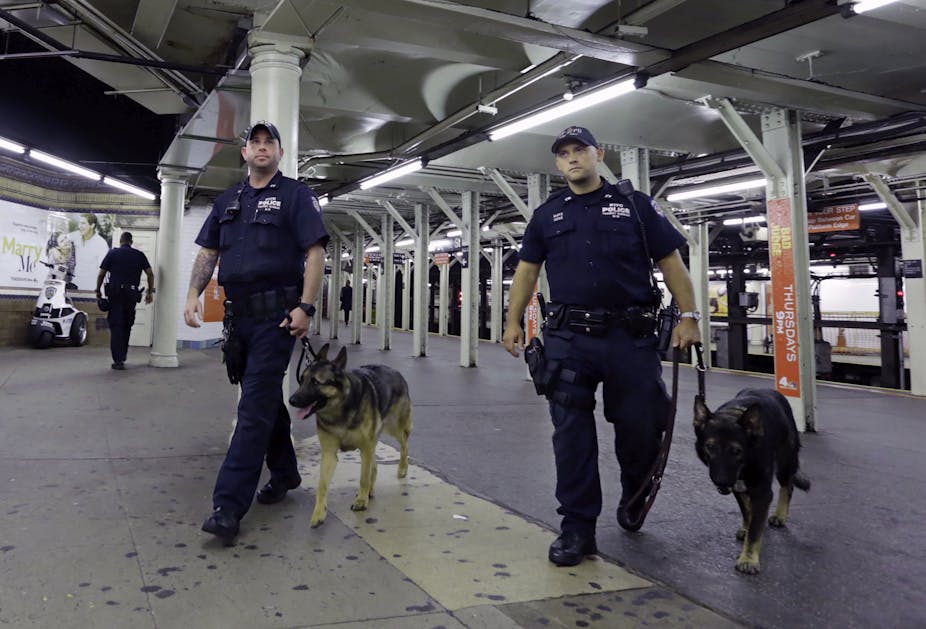Only the day before the UK parliament’s controversial decision to re-engage British military forces in Iraq, the Iraqi prime minister, Haider al-Abadi, claimed to have intelligence that Islamic State (IS) is preparing to attack subway systems in Paris and the United States.
American intelligence officials quickly denied the accuracy of the claim, which was based on evidence from arrested IS fighters. But still, both New York and Paris reportedly heightened security on their public transport systems in response.
As the Iraqi government openly and desperately lobbies for Western intervention, there are concerns that al-Abadi may be deliberately over-egging equivocal intelligence to stoke the fears of Western governments.
Those fears are very real: Western countries are feeling badly exposed to being targeted by terrorists from abroad and they are especially worried about the prospect of homegrown militants returning from Iraq and Syria – ticking time bombs who might either do IS’s bidding or launch freelance terrorist attacks of their own.
The potential of the risks, then, is clear – but what’s less certain is whether the intelligence and threat assessments driving the response to IS are actually based on credible evidence.
Known unknowns
Aside from the serious risk that intelligence is quite possibly being politicised to justify or provoke military and political responses, the intelligence picture of what IS and its associates are actually doing is patchy to say the least.
In a recent statement, the director of the America’s National Security Agency (NSA) Michael Rogers, conceded that his agency had struggled to keep track of IS’s quick evolution into the organised quasi-state it is operating as today. His colleague Matt Olsen, director of the US National Counterterrorism Center, readily admitted in mid-September that Syria is currently a “black box” for the intelligence community.
As he outlined the situation, individuals could be tracked travelling to Syria’s border and leaving the country, but estimating how many of those would join jihadist groups, such as IS, while staying in Syria was impossible. And at the same meeting, Homeland Security secretary Jeh Johnson essentially confirmed that the American intelligence picture of Syria consisted mostly of gaps.
And yet, despite this threadbare knowledge base, American and European threat assessments have frequently estimated the numbers of foreign fighters with an unnerving degree of certitude – even as their given estimates vary wildly.
Inflation
For example, whereas a previous estimate by the CIA estimated that about 10,000 foreign fighters had travelled to the region to join IS, CIA spokesperson Ryan Trapani suggested in early September that the agency now thinks IS “can muster between 20,000 and 31,500 fighters across Iraq and Syria, based on a new review of all-source intelligence reports from May to August”.
That estimate, increasing the original figure by up to three times, was provided just one day after Barack Obama announced his new US military offensive – offering a highly convenient justification for using considerable force.
European estimates have varied too: just before the British parliament’s decision, the EU’s anti-terrorism chief, Gilles de Kerchove, put the figure of Europeans joining militants in Iraq and Syria at around 3,000. But he also conceded that there is in fact no harmonised standard for collecting data on foreign fighters in Europe, making the validity of his estimate impossible to gauge.
Even more opaque are authorities’ assessments of direct threats to the US and Europe. Mike Rogers, chairman of the US House Intelligence Committee (not to be confused with the NSA chief) described the threat of foreign fighters in Syria as “very serious”; he apparently believes that “hundreds of American citizens” have already trained with IS at least once, and could return to the US to carry out attacks.
Most recently, the White House stated that “dozens of Americans” had joined terrorist groups in Syria. Some European countries, including the Netherlands, have raised their terrorist threat level on the assumption that fighters return home and conduct an attack.
But the actual capabilities of IS and its associates remain highly uncertain. Aside from al-Abadi’s dubious announcement, counter-terrorism officials have so far not publicly presented evidence that IS is planning attacks inside Europe or the US; some have directly questioned the group’s capacity for mounting any large-scale attacks at all.
Plugging the gaps
Given the considerable gaps and contradictions in the current intelligence picture, one of the top priorities for Western decision-makers ought to be figuring out how to gather effective and actionable intelligence.
For the counter-terrorism machinery the US, UK and their allies are using to actually function, it needs a precise and reliable intelligence picture to work with. Information exchange among the allies has to be a priority, and returning foreign fighters (if they can be identified) will of course be an important source of intelligence – but, above all, Western intelligence urgently needs to establish and foster reliable sources in the region.
Without it, the new anti-IS surge threatens to quickly degrade into another long and unfocused military campaign. That could drive extremists to a safe haven in another failed or fragile state, of which there are no shortage.
If that happens, the Middle East and West will face an even more opaque and poorly understood threat than the one they’re trying to stamp out today.

